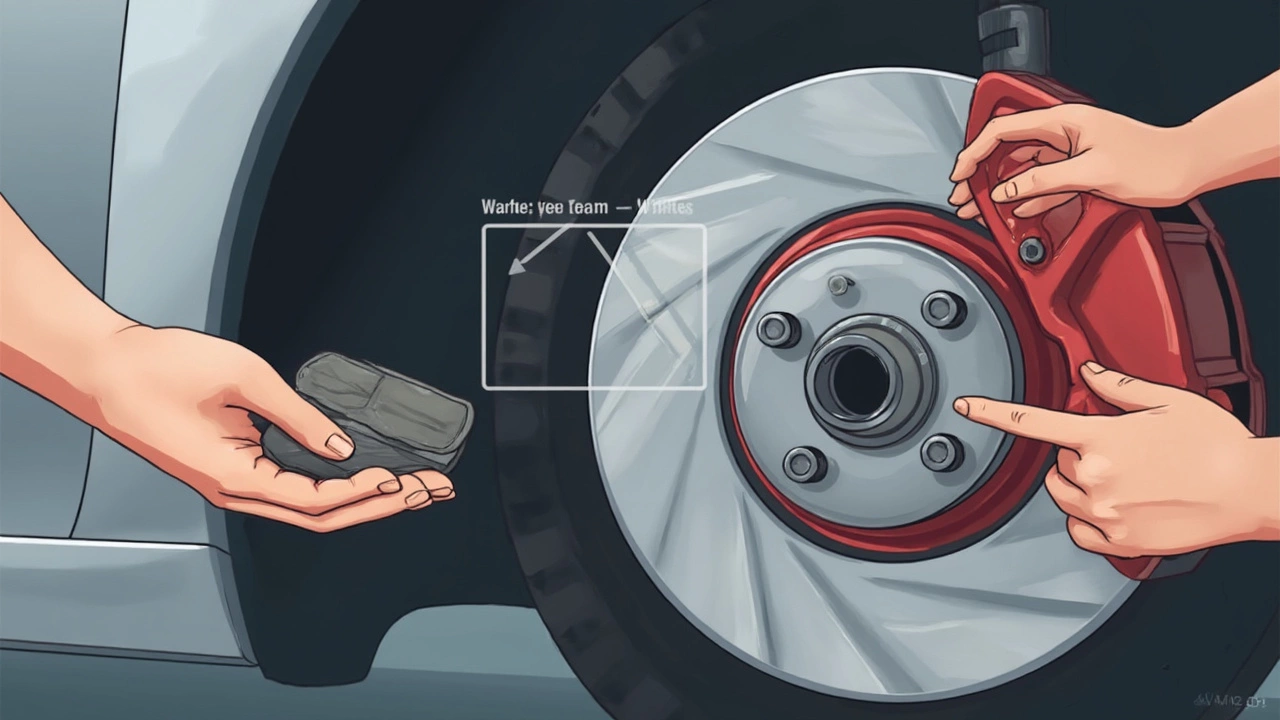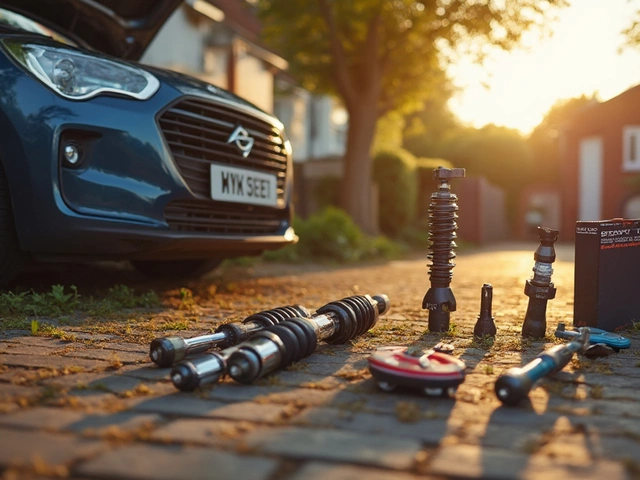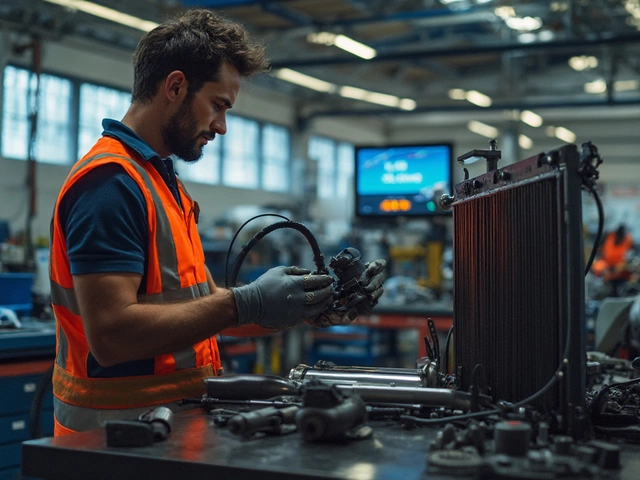Swapping out brake pads sounds way less painful on your wallet than a full brake job, right? But here’s the thing: just because you can buy pads at your local store, doesn’t mean that’s where you should stop. If you’re thinking about changing only the pads, you’re definitely not alone—lots of DIYers and even some shops do this to save time and money. But let’s get practical about what’s actually happening with your brakes.
Your brake pads clamp down on the rotors to stop your wheels. Over time, pads wear out (that’s their job). Rotors, though, take a beating too—especially if you wait too long between pad changes or if the pads have gotten super thin. If the rotors are rough, grooved, or warped, new pads on old rotors won’t grip right. That means less stopping power and maybe some nasty squealing or pulsing when you hit the brakes.
So, is it okay to change just the pads? Sometimes, yes. But skipping the full check can backfire fast. If you’re the kind of person who relies on the brakes every day (school drop-offs, soccer practice, rush hour traffic—yep, that’s my life with Gideon), you don’t want to risk it. The real question isn’t just about cost—it’s about safety and doing the job right.
- Why People Swap Only Brake Pads
- What Happens If You Skip the Rotors
- Spotting Warning Signs: Pads vs Rotors
- When It’s Safe to Change Pads Only
- Mistakes That Lead to Extra Repairs
- Tips for Stretching Your Brake Life
Why People Swap Only Brake Pads
Most folks choose to change only the brake pads because it’s cheaper and looks like a quick fix. Pads are the first part of the brake system to wear down since they’re built to take all the friction. You can usually spot a set for under $50, while rotors tend to bump the cost up way more. If you ask around, you’ll hear people say, “My rotors look fine!” But looks can mislead—just because they aren’t obviously gouged or warped doesn’t mean they’re perfect inside.
Shops and even experienced DIYers sometimes focus just on the pads because it saves about an hour or more of labor compared to swapping both. Here’s another reason: car makers often list pad replacement in regular maintenance schedules, but rotors aren’t always mentioned until they pass a certain thickness limit. That can make you think it’s okay to swap pads alone, especially if your car isn’t shaking or making noise when you stop.
For folks who use their cars for mostly city driving or school runs, changing brake pads only can seem just fine—at first. Many people don’t realize that every time you slam on the brakes, you’re wearing away both pads and rotors just a little bit more. On older cars, buying pads only is a classic “just keep it running” move, hoping to get a few more miles before throwing in the towel.
Here’s a quick comparison of average costs for swapping just pads versus both pads and rotors:
| Service | Average Cost (per axle) |
|---|---|
| Brake Pads Only | $100 - $150 |
| Brake Pads + Rotors | $250 - $350 |
If you’re tight on cash or just want a fast fix to pass inspection, swapping out only the pads might sound like the right call. But there’s more under the surface—and ignoring rotors could lead to headaches later on. The bottom line? It’s all about saving time and money in the short term, even if it’s not always the best move for your car’s stopping power.
What Happens If You Skip the Rotors
So, you’ve decided to swap out only the brake pads and leave those old rotors in place. Here’s what can really happen if you skip checking or replacing the rotors.
Let’s start with the science. When your pads press on the rotors every time you brake, the rotors get worn down and can develop grooves or even heat spots. If you bolt shiny new pads onto worn rotors, you create an uneven contact surface. That uneven spot leads to weaker stops and weird noises. You may hear squealing, grinding, or feel a shudder through the pedal. That’s not just annoying—it’s less safe for you and everyone else on the road around you.
Most car manuals (and every good mechanic I know) say that you should resurface or replace the brake rotors when you fit new pads, unless the rotors are super clean and smooth. If you ignore this, here’s what might happen:
- New pads wear out super fast because the rough surface chews them up.
- Your car takes longer to stop—in tests, worn rotors have been shown to add several feet to stopping distances, especially in emergency braking.
- You risk permanent damage to the rotors, which could cost you a whole new set next time, not just a quick resurface.
- Pulsating brake pedal from warped rotors ruins the feel—and makes driving stressful.
Actually, the Car Care Council shared that ignoring rotors could bump up brake-related repair costs by up to 35%. That's just burning money over something preventable.
If your rotors are below the minimum thickness (your mechanic can measure this), they’re more likely to crack or overheat, which is dangerous. Here’s a quick comparison to show why fresh rotors matter:
| Scenario | Brake Performance | Pad Wear Rate |
|---|---|---|
| New Pads + Worn Rotors | Poor (Less grip, more noise) | High (Pads wear out fast) |
| New Pads + New/Resurfaced Rotors | Optimal (Smooth, reliable stop) | Normal (Pads last longer) |
The bottom line? Skipping the rotors might seem like a shortcut, but it just isn’t worth the hassle and hidden costs. Give your brake pads a fighting chance—don’t ignore what’s going on with the rotors underneath.
Spotting Warning Signs: Pads vs Rotors
If you’re wondering whether it’s OK to change brake pads only, you need to know how to spot the warning signs when pads or rotors are on their last legs. Pads and rotors wear out differently, so knowing what to look for keeps you safe and helps you avoid money pit repairs later.
Let’s start with the pads. Here’s what you might notice when your brake pads are worn:
- Screeching or squealing when you hit the brakes—most pads have a little metal tab that rubs and makes noise when the pad is getting thin (usually less than 3mm left).
- Longer stopping distance than your car used to need.
- A kind of grinding feeling or loud rumble if things get really bad—now you’re probably down to metal on metal. That’s not good for your brake rotors either!
When it comes to rotors, the warning signs change a bit:
- A pulsing or wobble feel in the pedal—especially when braking at highway speed. That’s often due to warped rotors.
- Visible grooves, scoring, or an uneven lip around the edge of the rotor when you peek through your wheel spokes.
- Loud scraping or grinding, even after new brake pads are installed—that usually means the rotors are too rough for the new pads.
Here’s a quick snapshot of common brake warning signs and what they usually point to:
| Warning Sign | Common Cause |
|---|---|
| Squealing/noisy brakes | Worn pads |
| Vibration in pedal | Warped rotors |
| Grinding sound | Pads worn through to rotors |
| Grooved rotor surface | Rotor damage from old pads |
The longer you drive with worn pads, the more likely you’ll beat up your rotors, turning a simple brake pad swap into a big repair bill. If in doubt, check both—or have a pro take a look—it can save you from surprise expenses and keep your stopping power sharp.

When It’s Safe to Change Pads Only
So when is it legit to just slap on some new brake pads and call it a day? Honestly, it comes down to the shape of your brake rotors—and a bit of common sense. Most mechanics (at least the honest ones) will say it’s totally fine to only swap out the pads if your rotors are still in decent shape. Here’s what ‘decent shape’ really means:
- No deep grooves or scoring on the rotor face—just a smooth surface.
- No major rust, warping, or cracks.
- Rotor thickness is still above the minimum spec (usually stamped on the rotor itself or in your manual).
If your car’s rotors check out, installing just new pads might be all you need. A lot of modern cars have pretty tough rotors—sometimes they last through two or even three sets of brake pads before needing a change. For folks who don’t wait until the brakes are grinding to fix stuff, sticking with the pads only can be safe and budget-friendly.
Another reason it’s okay: if you’re changing brake pads on newer cars or cars that haven’t racked up a bunch of highway miles, the rotors often still look fresh. On some European and Japanese models, the service techs regularly just swap pads and go, provided the checklist above is clear.
It’s a good idea to measure rotor thickness with a micrometer or caliper. Most passenger cars need rotors to stay at least 20-22mm thick (check your specs). Here’s a quick look at how that works:
| Car Type | Typical Minimum Rotor Thickness |
|---|---|
| Sedan | 20-22mm |
| SUV | 28-32mm |
If you’ve kept up with regular maintenance and you don’t feel shaking or hear weird noises from your wheels, you’re probably good. Just don’t forget to break in those new pads right, so they bite and wear evenly.
Mistakes That Lead to Extra Repairs
Changing only the brake pads and leaving everything else untouched can actually lead to bigger problems—fast. One of the biggest mistakes people make is not checking the brake rotors for damage before tossing in new pads. If there are grooves, warping, or too much wear, new pads won’t seat right. That can cause uneven stopping, annoying noises, or even more rapid wear on your fresh pads.
Another classic blunder? Skipping the hardware. Those little clips and shims that come with new brake pads have a real job. If you reuse old, rusty hardware, your brakes might not release fully, or they might rattle and make your car sound worse than before. A noisy brake isn’t just a bother—it’s often a hint that something’s off.
One more thing that burns people—slapping new brake pads onto a glazed rotor. Glazing basically means the rotor’s gotten super smooth and shiny (almost glassy) from overheating. New pads on a glazed rotor can squeak and fade fast, and sometimes you’ll notice a drop in car safety: longer stopping distances and less control, especially in wet conditions.
Here’s a quick look at some common mistakes and what they can cost you down the road:
| Mistake | What Can Go Wrong | Possible Extra Cost |
|---|---|---|
| Skipping rotor resurfacing/replacement | Uneven wear, vibration, noise | $200-500 for new rotors and more labor |
| Not replacing brake hardware | Rattling, uneven wear, stuck brakes | $20-50 (plus pads wear out faster) |
| Poor cleaning of brake parts | Squealing, reduced performance | Lots of headache, possible return trip to mechanic |
If you’re set on swapping just the pads, at least check those rotors, change the hardware, and clean the area well. It takes a little more time, but it can save you from a double repair bill (and an earful from your kids when you’re stuck waiting for a tow truck at school pickup).
Tips for Stretching Your Brake Life
If you want to keep your brake pads (and your wallet) out of danger, paying attention to how you drive and how you maintain your car is key. The way you handle your brakes, even when you’re running late or stuck behind a slowpoke, can make a big difference in how long those pads last.
- Go easy on the pedal. Slamming on the brakes at every red light? Not great. Try to slow down gradually and anticipate stops. It seriously cuts down on wear.
- Keep an eye (and ear) out. If you hear squeaking, grinding, or feel a vibration when braking, don’t shrug it off. Catching problems early keeps damage from getting worse.
- Don’t just swap one pad. Always change brake pads on both wheels of the axle together—otherwise, you risk uneven braking and tearing up your rotors faster.
- Check your brake fluid. Low or dirty brake fluid can mess up your whole system. Top it up and follow your car’s schedule for flushing it out.
- Stay on top of tire care. Worn or underinflated tires mess with your stopping distance. That makes your brakes work way harder than they need to.
- Shed the heavy load. The more junk you carry, especially in city driving, the quicker your brakes wear out. Clear out what you don’t need.
Check out these numbers—according to a Consumer Reports study, drivers who routinely coast into stops and keep up with basic maintenance can get up to 40% more miles from their brake pads compared to hard-brakers.
| Driving Habit | Average Pad Life (Miles) |
|---|---|
| Smooth Braking | 45,000 – 60,000 |
| Frequent Hard Stops | 25,000 – 35,000 |
As Ray Magliozzi, mechanic and co-host of NPR’s Car Talk, puts it:
"If you treat your brakes like they’re made of gold, you’ll spend less gold replacing them."
Simple habits count. Smooth, steady driving pays off, and checking on your brake pads whenever you rotate your tires is a smart move. No big secrets—just the right kind of attention (and a little less leadfoot action).






